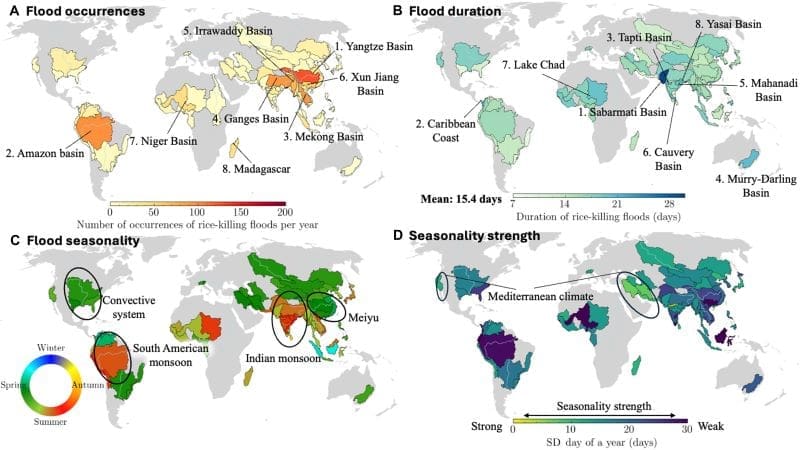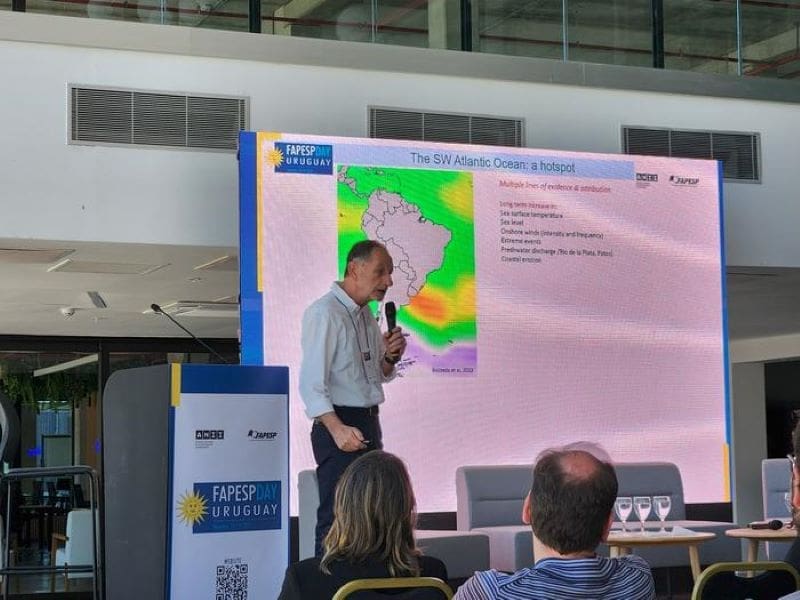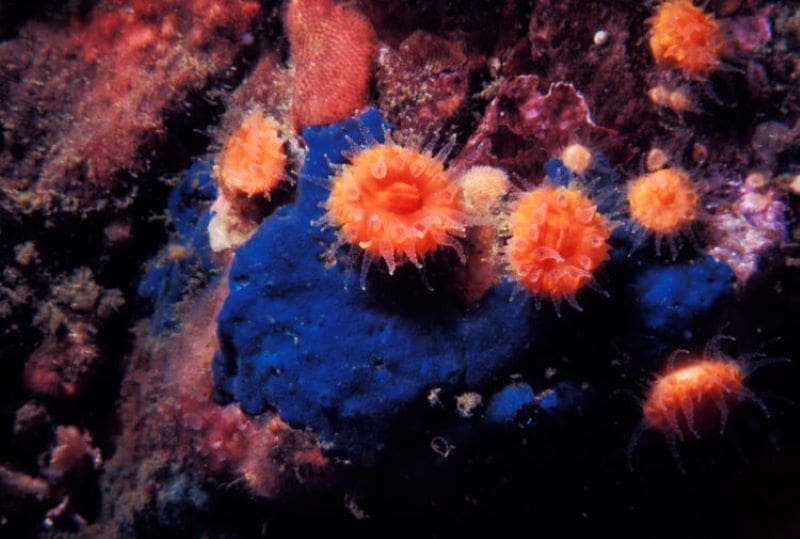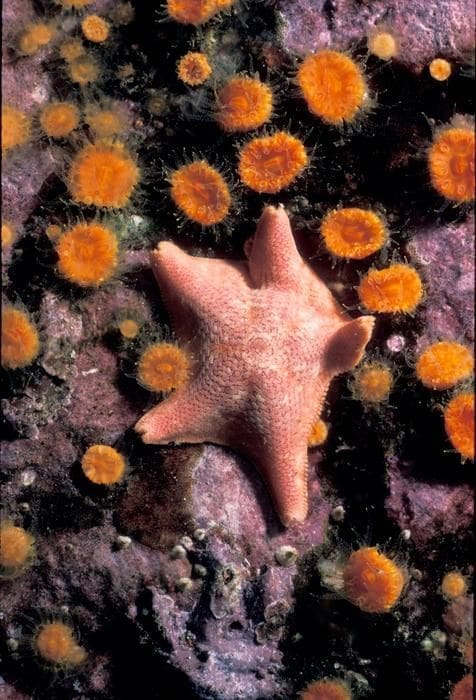Explore the latest insights from top science journals in the Muser Press roundup (November 17, 2025), featuring impactful research on climate change challenges.
In brief:
Climate change and rising sea levels to worsen urban health risks in Mumbai
Rainfall and flooding frequently disrupt the lives of urban residents worldwide, posing significant public health risks. Mumbai, India – renowned for the ferocity of its monsoon season – stands as a stark example of the human toll that extreme urban flooding can exact. But despite the growing recognition and urgency of these hazards, the health impacts of rainfall remain poorly understood, and those of sea level rise are entirely unquantified.
A recent study, published in Nature, led by Princeton University and the University of Chicago takes a closer look at the intersection between climate change, hazards, and public health in Mumbai, finding that deaths caused by rainfall and rising sea levels are almost ten times higher than the official statistics suggest.
Background: Monsoon Season in Mumbai
Mumbai is known for its heavy rainfall during the June to September monsoon season. Located between the coast of the Arabian Sea and the foothills of the Western Ghats mountain range, Mumbai’s climate leads to the city receiving a significant amount of rainfall, with some days bringing more than 300 mm (11.8 inches) of rain.
One of the most infamous examples is the Maharashtra floods of 2005, that caused a catastrophic level of flooding in Mumbai. During this flood, the city received a record-breaking 944 mm (37.2 inches) of rainfall, leading to over 1,000 deaths, hundreds of millions of dollars in damages, and the forced evacuation of hundreds of people.

“Mumbai is one of the world’s largest and fastest growing cities,” says co-first author and STEP Ph.D. student, Tom Bearpark. “Each year, torrential monsoon season rains cause widespread disruption, closing roads, damaging infrastructure, and endangering lives.”
The Data and Methods
Drawing on a unique combination of high-resolution datasets, the researchers linked individual death records with sub-daily rainfall data from the Municipal Corporation of Greater Mumbai (MCGM), encompassing the city’s monsoon seasons from 2006 to 2015. Each death was matched with highly localized rainfall measures using residential addresses and categorized as “slum” or “non-slum” residents based on census lists.
The team then used an econometric model that captures both the immediate and delayed effects of rainfall on mortality in each of Mumbai’s 89 PIN (i.e., postal) codes, allowing the impact to vary by age, gender, and residential status. They also developed a new method that estimates the mortality impacts of hourly rainfall whilst accounting for tide height, a crucial factor for a coastal city like Mumbai.
“We developed a model which allows the impacts of rainfall to differ based on the level of the tide during the hour in which the rain fell,” explains Bearpark. “This model allows us to quantify how rising sea levels could amplify the health impacts of rainfall in the future.”
The Results
The findings are sobering. The results showed that rainfall accounts for more than 8% of deaths during the monsoon season in Mumbai – an estimate that is almost 10 times that of official statistics.
Slum residents were overwhelmingly represented in monsoon deaths, representing over 80% of rainfall-induced mortality. Among children under five, 18% of deaths were attributed to rainfall during the monsoon period. The study also found that women face higher risks than men.
“Our results illustrate a deep inequality in the impacts of extreme weather and future climate change, with poorer areas facing disproportionate damages,” says Bearpark. “Differences in drainage, sanitation, and access to healthcare and resources vary greatly within cities, leading to extremely unequal impacts.”
The researchers warn that climate change will likely worsen this crisis. Even a modest sea level rise of 5 centimeters – a change already plausible by 2030 – could increase the share of mortality caused by rainfall from 8.5% to 9.1% of total deaths, a 7% increase. Under 15-centimeters of sea level rise rainfall-related deaths could reach 10% of total deaths, representing a 21% increase. These changes in sea-level are small compared to projections for Mumbai by 2050, underscoring how even modest increments of sea level rise can significantly increase rainfall-induced health risks in low-lying, densely populated cities.
The Implications
Beyond its implications for Mumbai, this study offers vital lessons for cities across the world. The authors emphasize the importance of investing in water infrastructure, sanitation, waste management, and drainage systems when combating rainfall mortality.
The authors also call for an urgent expansion of climate impact assessments that move beyond the focus of temperature-related mortalities and account for the health risks posed by rainfall and sea level rise.
“While our study reveals that rainfall and flooding pose major public health challenges, it also points to the value of targeted investments in sanitation, clean water, waste management, and drainage systems in saving lives and reducing inequality,” explains co-first author Ashwin Rode, the Director of Scientific Research at the University of Chicago’s Energy Policy Institute. “Climate change is already bringing intensified rainfall and rising sea levels worldwide. The time to make these investments is now.”
Journal Reference:
Bearpark, T., Rode, A. & Patankar, A., ‘Mortality impacts of rainfall and sea-level rise in a developing megacity’, Nature (2025). DOI: 10.1038/s41586-025-09730-4
Article Source:
Press Release/Material by Princeton School of Public and International Affairs (Princeton SPIA)
Severe floods threaten global rice yields, study finds
Severe flooding has slashed global rice yields in recent decades, threatening food security for billions of people who depend on the grain. The losses amounted to approximately 4.3%, or 18 million tons of rice per year, between 1980 and 2015, according to research from Stanford University published in Science Advances.
Damage has accelerated since 2000 due to more frequent extreme floods across major rice-growing regions, a trend likely to be exacerbated by climate change, the researchers found.
Scientists and farmers have long understood that rice yields suffer during droughts. The new study adds to evidence of that damage, finding that droughts reduced rice yields by an average of 8.1% per year during the 35-year study period. But it also highlights a less studied threat. Although rice crops benefit from shallow flooding during early growth stages, too much water for too long can be devastating.
“While the scientific community has focused on damage to rice yield due to droughts, the impacts of floods have not received enough attention,” said Steven Gorelick, the study’s senior co-author and a professor of Earth system science in the Stanford Doerr School of Sustainability. “Our research documents not only areas where rice yields have suffered due to past flooding, but also where we can anticipate and prepare for this threat in the future.”

Defining ‘rice-killing floods’
The study clearly defines for the first time what makes a flood deadly for rice crops, said lead study author Zhi Li, who worked on the research as a postdoctoral fellow in Gorelick’s lab at Stanford and recently joined the faculty of the University of Colorado Boulder.
A full week underwater during the plant’s growth cycle is the key threshold. “When crops are fully submerged for at least seven days, most rice plants die,” Li said. “By defining ‘rice-killing floods,’ we were able to quantify for the first time how these specific floods are consistently destroying one of the most important staple foods for more than half of the global population.”
To assess the damage from past droughts and floods, the scientists used information about rice growth stages, annual global rice yields, a global dataset of droughts and floods since 1950, a model of flood dynamics, and a simulation of soil moisture levels in the world’s major rice-growing basins over time.
The new analysis suggests that in the next few decades, the most extreme week of rainfall across the world’s major rice-growing river basins could bring 13% more rain compared to the average for those regions during the 1980-2015 baseline period.
Flood-resistant varieties can help
Greater adoption of flood-resistant rice varieties could help to avert future losses, especially in regions where the crop is at highest risk. These include the Sabarmati Basin in India, which experiences the longest rice-killing floods, as well as North Korea, Indonesia, China, the Philippines, and Nepal, where the impact from rice-killing floods has grown the most in recent decades. The largest losses overall have been in North Korea, East China, and India’s West Bengal.
The research also uncovered exceptions such as India’s Pennar Basin, where floods appear to enhance rice yields. According to the authors, this may be explained by such regions’ hot, dry climates, which allow stagnant floodwater to evaporate quickly.
For Gorelick and Li, the latest findings underscore the importance of understanding how rice yields respond to floods, droughts, heatwaves, and cold stress individually and in sequence. Previous research has shown that sequences of weather whipping from drought to flood and back again result in nearly twice the rice yield loss compared to individual flood or drought events alone. According to the authors, “How these combined effects can be mitigated remains a major challenge.”
Journal Reference:
Zhi Li, Lorenzo Rosa and Steven Gorelick, ‘Severe floods significantly reduce global rice yields’, Science Advances 11, (46): eadx7799 (2025). DOI: 10.1126/sciadv.adx7799
Article Source:
Press Release/Material by Josie Garthwaite | Stanford University
‘Almost half of the beaches will disappear by the end of the century,’ warns researcher
Beaches around the world are undergoing a process of “crushing” due to a combination of rising sea levels caused by climate change and urbanization in coastal areas. This phenomenon not only profoundly affects the biodiversity living on the sand, but it also harms activities such as fishing and tourism. Additionally, it makes coastal cities more susceptible to the advance of the sea.
The warning was issued during the FAPESP Day Uruguay symposium, which began on November 13 in Montevideo, by Uruguayan marine scientist Omar Defeo, a professor at Uruguay’s University of the Republic (UdelaR).
“Almost half of the beaches will disappear by the end of the century. We in Uruguay, Brazil, and Argentina share these resources. Therefore, we must work in partnership with Brazilian scientists to manage and conserve coastal ecosystems,” Defeo said in his presentation.

As the researcher explained, the coastal ecosystem can be divided into three zones: the dune (post-beach), which is the area above the high tide line where sand accumulates due to wind action, forming mounds or “sand mountains”; the beach (beach face), a strip of sand exposed during low tide and submerged during high tide; and the submerged part (foreshore), which extends from the lower limit of low tide to the zone where waves begin to break.
“These zones form an interconnected coastal ecosystem that’s essential for environmental balance. How are they interconnected? The wind carries sand from the dry area to the surf zone [the submerged part]. And when the waves advance, they bring the sediment back to the beach. This bidirectional movement generates a constant exchange in which one zone feeds the other. When a storm comes, the dune acts as a buffer. So when urbanization eliminates the dune, the result can be the destruction of seaside homes,” said the scientist.
In a study conducted in collaboration with Brazilian researchers supported by FAPESP (17/17071-9, 18/22036-0, 18/05099-9, and 18/19776-2), Defeo’s group demonstrated that when one of these three coastal zones is compromised by urbanization, the effects harm the entire ecosystem. The study, led by Brazilian researcher Guilerme Corte, analyzed biodiversity at 90 locations along 30 beaches on the northern coast of São Paulo, Brazil.
The results, published in the journal Marine Pollution Bulletin, show that the number of beachgoers is the most impactful urbanization variable and correlates negatively with species richness and biomass, especially in submerged areas. The presence of buildings on the sand and mechanical cleaning activities also reduce biomass and species richness. Interestingly, abundance (number of individuals) was higher in locations close to urban centers. According to the authors, this is due to an increase in opportunistic species, such as polychaetes, which benefit from the supply of organic matter associated with human activity.
“Above all, the study showed that human impacts aren’t restricted to the place where they occur [on dry sand]. Stressors such as construction and high numbers of visitors on the upper part of the beach negatively affect biodiversity in the lower and submerged areas,” he said.
Another study conducted by Defeo in partnership with Brazilian scientists and published in the journal Frontiers in Marine Science showed that one-fifth of the 315 beaches analyzed around the globe have intense, extreme, or severe erosion rates. The group analyzed the various factors behind the phenomenon, including sea level rise, wind patterns, and waves. “We observed that human activities play a significant role, particularly on reflective beaches [with a steep slope that causes waves to dissipate their energy abruptly on the beach] and intermediate beaches [which have characteristics of both reflective beaches and calm or dissipative beaches],” he pointed out.
Defeo’s presentation took place during the first scientific session of the symposium, which was dedicated to oceanographic sciences. Other participants included Marcelo Dottori from the University of São Paulo (USP), who moderated the panel; Cristiana Seixas from the State University of Campinas (UNICAMP); and Natália Venturini from UdelaR.
The opening ceremony of the event was attended by Alvaro Brunini, president of Uruguay’s National Research and Innovation Agency (ANII); Marcio de Castro, scientific director of FAPESP; Raul Machado, manager of the Foundation’s Institutional Relations Advisory and coordinator of the symposium; and Brazil’s ambassador to Uruguay, Marcos Leal Raposo Lopes.
Journal Reference:
Guilherme N. Corte, Helio H. Checon, Yasmina Shah Esmaeili, Omar Defeo, Alexander Turra, ‘Evaluation of the effects of urbanization and environmental features on sandy beach macrobenthos highlights the importance of submerged zones’, Marine Pollution Bulletin 182, 113962 (2022). DOI: 10.1016/j.marpolbul.2022.113962
Bozzeda F, Ortega L, Costa LL, Fanini L, Barboza CAM, McLachlan A and Defeo O, ‘Global patterns in sandy beach erosion: unraveling the roles of anthropogenic, climatic and morphodynamic factors’, Frontiers in Marine Science 10: 1270490 (2023). DOI: 10.3389/fmars.2023.1270490
Article Source:
Press Release/Material by Karina Toledo | Agência FAPESP | Fundação de Amparo à Pesquisa do Estado de São Paulo (FAPESP)
Carbon-rich waters are becoming even more acidic as atmospheric CO₂ levels rise
Earth’s oceans have become approximately 30% more acidic since the industrial revolution began more than 200 years ago. Acidification changes marine chemistry and depletes key minerals that calcifying organisms, such as corals and clams, need to build their skeletons and shells. The Northeastern Pacific is naturally more acidic than other oceans, fueling debate about how much its chemistry will change in the coming decades.
The study, published in Nature Communications, shows that high baseline acidity makes the water more sensitive to additional carbon dioxide from human activities. Analyses of coral skeletons from the past century revealed that CO₂ has been accumulating in North American waters faster than in the atmosphere, driving rapid acidification.

“This fits into a class of really important records that show how the world has changed over the human era,” said senior author Alex Gagnon, a University of Washington associate professor of oceanography.
“The findings implicate not only marine ecosystems, but all of the people who depend on them as well,” added lead author Mary Margaret Stoll, a UW doctoral student of oceanography.
The ocean becomes more acidified when carbon dioxide dissolves to form an acid that releases hydrogen and bicarbonate ions, lowering the water’s pH level. In North America, a powerful current system – the California Current – transports cool water south along the coast. The combination of current flow and wind creates optimal conditions for upwelling, a process that cycles deep water to the surface.
Organic matter – dead plants and animals – sinks to the bottom of the ocean, where it decomposes and releases carbon dioxide back into the water. Upwelling surfaces this CO₂ rich water, increasing the acidity of subsurface and surface zones. These natural fluctuations complicate researchers’ efforts to predict how much acidification will occur from human activities.
This study helps resolve these questions with records kept by centuries old corals.
Coral incorporates elements and minerals from seawater as it grows, leaving behind a valuable record of environmental conditions in its skeleton. The Pacific Ocean is home to a small vibrant species called orange cup corals. Gagnon’s lab was already studying orange cup corals when the researchers became interested in historic samples.
In 2020, the researchers began collecting samples – first from the Smithsonian Museum, and then from labs and museums all over the U.S. and Canada. They procured a total of 54 samples collected between 1888 and 1932 from the Salish Sea, the body of water connecting Washington state and Canada, and North American coastal waters.

Using handwritten records in logbooks, the researchers then navigated back to the original collection sites. They took orange cup corals from the same spots, sometimes more than a century later.
To plot CO₂ and acidity over time, the researchers analyzed boron levels in the coral skeletons. In seawater, boron exists in several chemical forms that vary with acidity. Corals incorporate one of these forms into their skeletons as they grow, so the boron ratio in coral skeletons reflects the acidity of the seawater in which they formed.
Between 1888 and 2020, coral skeletons indicate that CO₂ in seawater increased at a rate that outpaced the addition of greenhouse gases to the atmosphere. The magnitude of acidification was also higher 100 to 200 meters below the surface, even though ocean acidification is typically characterized as a surface process.
“No one has acidity measurements older than a few decades,” Gagnon said. “We had to go back in time and do some detective work to pull some kind of chemical signal out of the world and show this unfortunate amplification effect.”
The amplification effect will likely strengthen as atmospheric CO₂ levels continue to climb. In the study, the researchers modeled worst case scenarios to see what could happen to species if acidification continues unchecked.
“The changes in ocean chemistry were really dramatic,” Stoll said. “The Salish Sea is a region with a lot of cultural, commercial and recreational ties to marine organisms that are all rooted in the health of these ecosystems.”
Despite the tenor of their results, the researchers say there is still time to course correct.
“This is no time for nihilism. The ocean is not destroyed,” Gagnon said. “As very large emitters per capita, we have the power to change our emissions and influence outcomes for the oceans.”
Studying regions where ocean acidification is happening faster than elsewhere can also provide key insights and warning signs.
“This is a uniquely important area to study,” Stoll said. “It is at the leading edge of ocean acidification impacts and provides a window into conditions predicted for the rest of the ocean in the coming decades.”
Journal Reference:
Stoll, M.M.V., Deutsch, C.A., Jurikova, H. et al., ‘A century of change in the California Current: upwelling system amplifies acidification’, Nature Communications 16, 9661 (2025). DOI: 10.1038/s41467-025-63207-6
Article Source:
Press Release/Material by Gillian Dohrn | University of Washington (UW)
Featured image credit: Gerd Altmann | Pixabay




